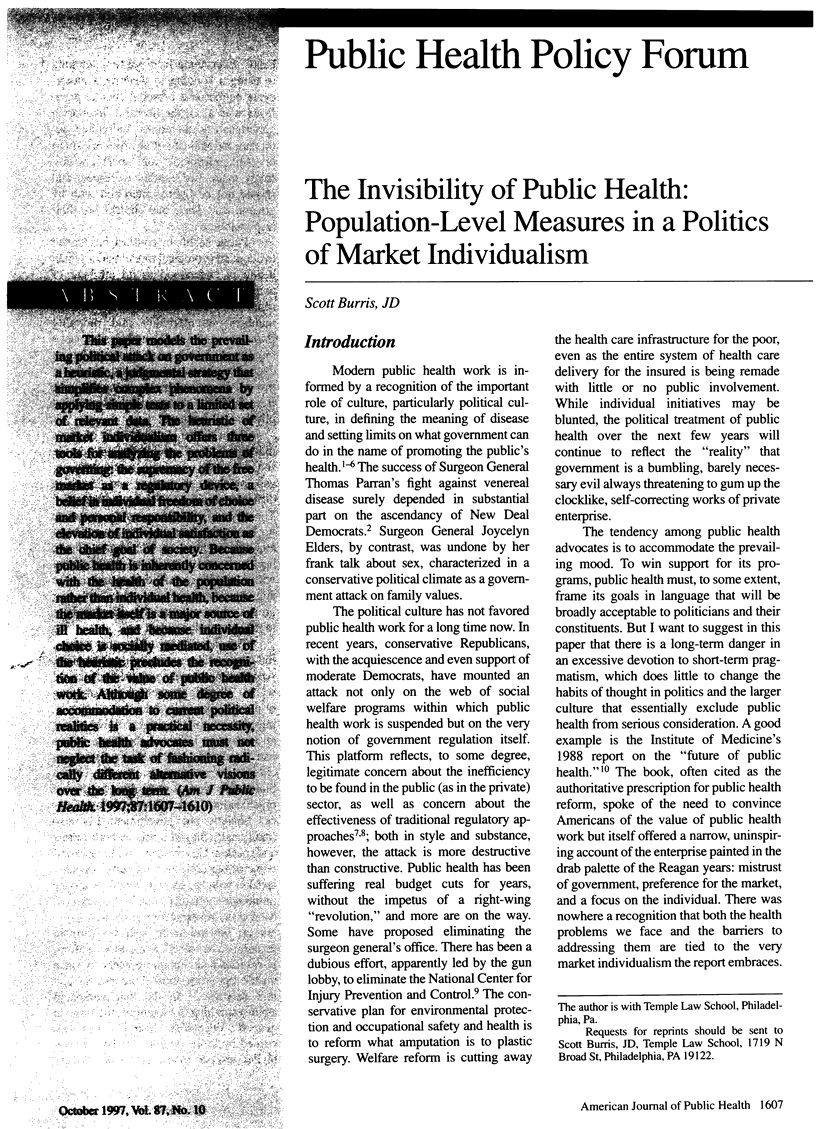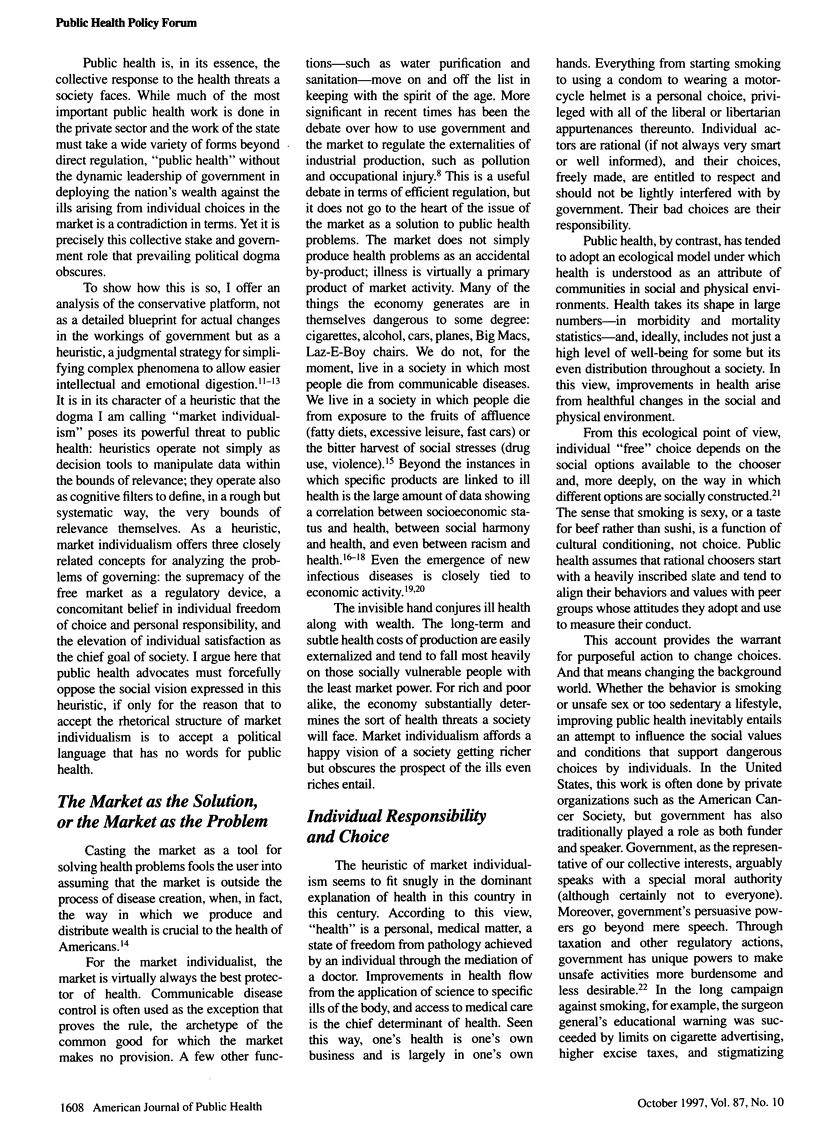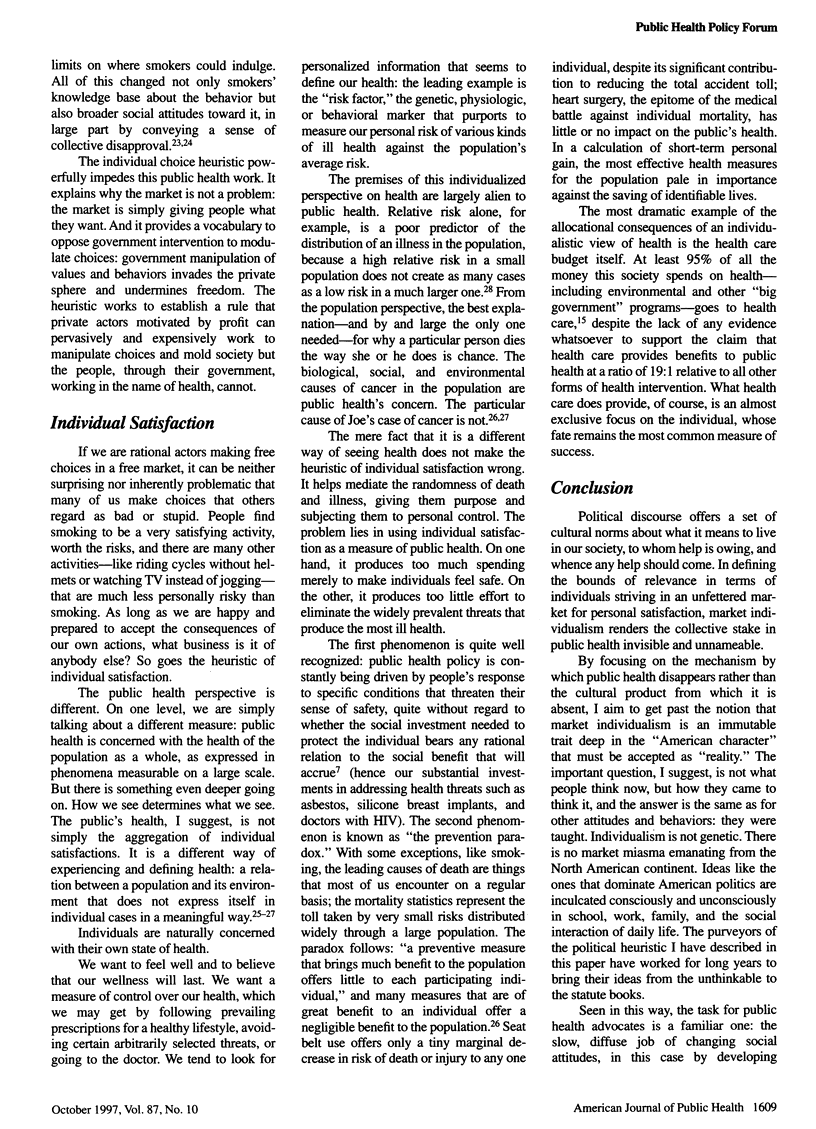Abstract
This paper models the prevailing political attack on government as a heuristic, a judgmental strategy that simplifies complex phenomena by applying simple tests to a limited set of relevant data. The heuristic of market individualism offers three tools for analyzing the problems of governing: the supremacy of the free market as a regulatory device, a belief in individual freedom of choice and personal responsibility, and the elevation of individual satisfaction as the chief goal of society. Because public health is inherently concerned with the health of the population rather than individual health, because the market itself is a major source of ill health, and because individual choice is socially mediated, use of the heuristic precludes the recognition of the value of public health work. Although some degree of accommodation to current political realities is a practical necessity, public health advocates must not neglect the task of fashioning radically different alternative visions over the long term.
Full text
PDF



Selected References
These references are in PubMed. This may not be the complete list of references from this article.
- Egolf B., Lasker J., Wolf S., Potvin L. The Roseto effect: a 50-year comparison of mortality rates. Am J Public Health. 1992 Aug;82(8):1089–1092. doi: 10.2105/ajph.82.8.1089. [DOI] [PMC free article] [PubMed] [Google Scholar]
- Epstein P. R. Emerging diseases and ecosystem instability: new threats to public health. Am J Public Health. 1995 Feb;85(2):168–172. doi: 10.2105/ajph.85.2.168. [DOI] [PMC free article] [PubMed] [Google Scholar]
- Fee E., Krieger N. Thinking and rethinking AIDS: implications for health policy. Int J Health Serv. 1993;23(2):323–346. doi: 10.2190/GH7C-LQE5-YNK5-JYM8. [DOI] [PubMed] [Google Scholar]
- Feinstein J. S. The relationship between socioeconomic status and health: a review of the literature. Milbank Q. 1993;71(2):279–322. [PubMed] [Google Scholar]
- Fox D. M. The history of responses to epidemic disease in the United States since the 18th century. Mt Sinai J Med. 1989 May;56(3):223–229. [PubMed] [Google Scholar]
- Jeffery R. W. Risk behaviors and health. Contrasting individual and population perspectives. Am Psychol. 1989 Sep;44(9):1194–1202. doi: 10.1037//0003-066x.44.9.1194. [DOI] [PubMed] [Google Scholar]
- Kassirer J. P. A partisan assault on science--the threat to the CDC. N Engl J Med. 1995 Sep 21;333(12):793–794. doi: 10.1056/NEJM199509213331209. [DOI] [PubMed] [Google Scholar]
- Keeney R. L. Decisions about life-threatening risks. N Engl J Med. 1994 Jul 21;331(3):193–196. doi: 10.1056/NEJM199407213310311. [DOI] [PubMed] [Google Scholar]
- Laveist T. A. Segregation, poverty, and empowerment: health consequences for African Americans. Milbank Q. 1993;71(1):41–64. [PubMed] [Google Scholar]
- Link B. G., Phelan J. Social conditions as fundamental causes of disease. J Health Soc Behav. 1995;Spec No:80–94. [PubMed] [Google Scholar]
- McGinnis J. M., Foege W. H. Actual causes of death in the United States. JAMA. 1993 Nov 10;270(18):2207–2212. [PubMed] [Google Scholar]
- Northridge M. E. Public health methods--attributable risk as a link between causality and public health action. Am J Public Health. 1995 Sep;85(9):1202–1204. doi: 10.2105/ajph.85.9.1202. [DOI] [PMC free article] [PubMed] [Google Scholar]
- Rose G. Sick individuals and sick populations. Int J Epidemiol. 1985 Mar;14(1):32–38. doi: 10.1093/ije/14.1.32. [DOI] [PubMed] [Google Scholar]
- Wilson M. E. Infectious diseases: an ecological perspective. BMJ. 1995 Dec 23;311(7021):1681–1684. doi: 10.1136/bmj.311.7021.1681. [DOI] [PMC free article] [PubMed] [Google Scholar]


